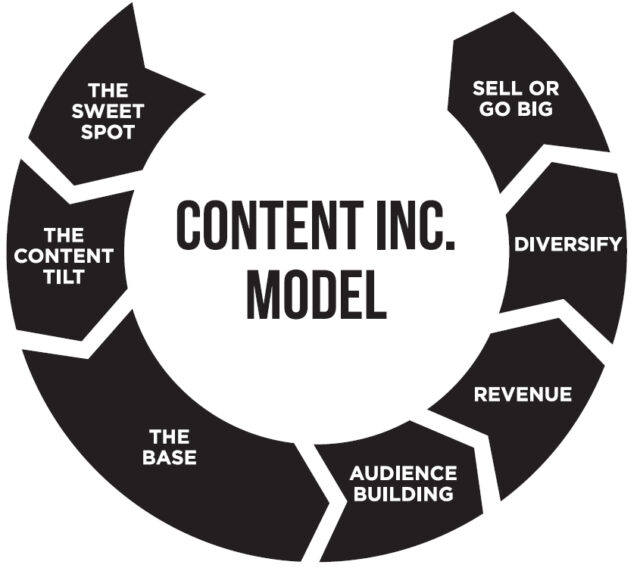
The 5C’s of Effective Content Marketing: A Deep Dive
Sep 28, 2024 5 Min Read 4478 Views
(Last Updated)
In a world oversaturated with advertisements, breaking through the clutter to reach your audience is more challenging than ever. Traditional marketing strategies, heavily reliant on advertising, are losing their effectiveness as consumers grow weary of the constant barrage of ads. Enter the revolutionary approach of content marketing—a strategy that diverges from traditional advertising to connect with customers more meaningfully.
Amidst the flood of content online, standing out requires more than just posting regularly; it demands a strategic approach encapsulated by the 5C’s of effective content marketing: Calibrate, Create, Curate, Circulate, and Convert. Let’s delve deeper into each of these components to understand how they can transform your content marketing efforts.
Table of contents
- The Power of Content Marketing
- Introduction to the 5C's of Content Marketing
- Calibrate: Strategy Before Execution
- Create: Crafting Impactful Content
- Curate: Enhancing Value through Selection
- Circulate: Distributing Content Effectively
- Convert: Driving Action through Content
- Implementing the 5C's in Your Strategy
- Writing Tips for a Professional, Expert Tone
- Use Clear, Concise Language
- Avoid Jargon, But When Necessary, Explain It
- Present Data or Evidence
- Favor Active Voice Over Passive Voice
- Structure and Organization Are Key
- Proofread to Maintain Professionalism
- Final Thoughts: The 5C's of Effective Content Marketing
- FAQs
- How can I determine the appropriate level of technical language to use in my content?
- What are some effective ways to present data or evidence in my content?
- How much time should I allocate to proofreading my content?
The Power of Content Marketing
Joe Pulizzi’s “Content Inc.” presents a compelling case for the shift toward content marketing. Unlike conventional advertising, which often interrupts the consumer experience, content marketing offers value through engaging, informative, and tailored content that meets the audience’s needs and interests.

Studies highlighted by the Content Council and Content+ reveal that consumers are more inclined to purchase from companies that provide valuable content, with 61% favoring content over ads. This shift is not just a trend but a fundamental change in how businesses communicate with their potential customers.
Unleash your potential with GUVI’s dynamic Business Analytics and Digital Marketing course. This comprehensive 6-months program with job placement assistance combines a high-quality vetted curriculum, real-world examples, and practical applications to provide one with a solid foundation in the industry. It’s more than just a course; it’s your pathway to success in the digital world. 🚀
Must Read: What is Content Marketing? Types, Uses, Strategy For 2024
Introduction to the 5C’s of Content Marketing
As we delve into the core of effective content marketing, it’s essential to understand the 5C’s that form the backbone of any successful content marketing strategy. These 5C’s are:
Content Creation: The foundation of content marketing, where businesses produce valuable and relevant content tailored to their audience’s interests and needs.
Content Curation: The process of sourcing, organizing, and sharing existing content to add value to your audience’s experience.
Content Consistency: Maintaining a regular schedule for content publication to keep the audience engaged and attract new viewers.
Content Collaboration: Partnering with other creators, influencers, or brands to expand your content’s reach and bring fresh perspectives to your audience.
Content Calibration: Continuously analyzing your content’s performance and adjusting your strategy based on insights gathered from your audience’s engagement and feedback.
8 Best Digital Marketing Courses Available on the Internet
As we explore each of these components in detail, we’ll uncover how they contribute to building a robust content marketing strategy that can attract massive audiences and create radically successful businesses, as outlined by renowned personalities in content advertisement.
1. Calibrate: Strategy Before Execution
Before diving into content creation, calibrating your marketing strategy is crucial. This involves setting clear objectives and key performance indicators (KPIs) to guide your content efforts. Understanding your goals—whether it’s increasing brand awareness, driving sales, or enhancing customer engagement—allows you to tailor your content effectively.
Remember, a well-calibrated strategy ensures that every piece of content serves a purpose, aligning with your overall business objectives.
Know More About Top 15 B2B Digital Marketing Strategies in 2024 [Updated]
2. Create: Crafting Impactful Content
Creation is at the heart of content marketing. This stage is about producing content that resonates with your audience, whether through blog posts, videos, infographics, or podcasts. However, creating great content isn’t just about what you make but how you make it.
It requires a mindset of agility and responsiveness, aiming to engage your audience through quality and relevance. Engaging content is not only informative but also captivating, encouraging your audience to interact and share.
Must Know About Top 9 AI Tools for Content Creation That You Shouldn’t Miss
3. Curate: Enhancing Value through Selection
Curation plays a vital role in your content strategy, involving the careful selection and sharing of external content that complements your original creations. Effective curation adds value by introducing your audience to relevant information and perspectives, thereby positioning your brand as a thought leader in your industry.
Remember, the goal of curation is not just to fill gaps in your content calendar but to enrich your audience’s understanding and engagement with your brand.
Must Explore: 8 Steps to Make an Effective Digital Marketing Plan
4. Circulate: Distributing Content Effectively
Once you’ve created and curated your content, circulating it across the right channels is crucial. Distribution is about ensuring that your content reaches your intended audience where they are most active. This could mean leveraging social media platforms, email newsletters, or even traditional methods like direct mail.
Circulation is not just about spreading your content but doing so intelligently to maximize visibility and engagement.
Also Read: Top 10 SEO Techniques For Better Ranking in 2024
5. Convert: Driving Action through Content
The ultimate goal of content marketing is to inspire action, leading us to the final C: Convert. This involves crafting compelling calls-to-action (CTAs) that guide your audience towards the next steps—be it making a purchase, signing up for a newsletter, or downloading a white paper.
Conversion-focused content aligns with the interests and needs of your audience, offering clear pathways to engage further with your brand.
Must Read: How to Learn Digital Marketing in 2024?
Implementing the 5C’s in Your Strategy
To effectively implement the 5C’s, start with a thorough analysis of your current content efforts and audience insights. Identify gaps and opportunities for improvement, focusing on areas that align closely with your business goals.
Engage your team in brainstorming sessions to generate creative ideas for content that resonates with your audience, and develop a content calendar that balances creation and curation.
Remember, content marketing is a dynamic field. Regularly review and adjust your strategy based on performance metrics and feedback, ensuring your content remains relevant and impactful.
The Scope of Digital Marketing in 2024
Writing Tips for a Professional, Expert Tone
Adopting a professional, expert tone in your writing not only enhances readability but also establishes your credibility and authority on the subject matter. Here are key strategies to achieve this:
Use Clear, Concise Language
The essence of professional writing is clarity. Opt for simple, straightforward language that conveys your message without ambiguity. Avoid using complex words when simpler ones will do. This approach ensures your content is accessible to a broader audience, including those who may not be familiar with the topic.
Avoid Jargon, But When Necessary, Explain It
While industry-specific terms or jargon can sometimes be unavoidable, they can also alienate readers who are not specialists in your field. Whenever you use technical terms, follow them with clear, concise explanations. This not only makes your content more accessible but also educative, helping readers learn something new.
Present Data or Evidence
Backing up your claims with data or evidence adds weight to your arguments and reinforces your position as an expert. Whenever possible, include relevant statistics, research findings, or case studies to support your points. Ensure to cite your sources to enhance the credibility of your information.
Explore: The Top 15 Most Important SEO Ranking Factors in 2024
Favor Active Voice Over Passive Voice
Active voice makes your writing more direct and lively, which can be more engaging for the reader. For instance, instead of writing “The project was completed by the team in a month,” say “The team completed the project in a month.” This shift not only makes your sentences clearer but also emphasizes the subject’s action.
Structure and Organization Are Key
A well-structured piece of writing guides the reader through your argument logically and coherently. Start with an introduction that outlines the main points, followed by a series of paragraphs that delve into each point in more detail, and conclude with a summary that ties everything together. Use headings and subheadings to break up the text and make it easier to navigate.
Proofread to Maintain Professionalism
Typos, grammatical errors, and spelling mistakes can significantly undermine your credibility. Take the time to proofread your work carefully, or consider using professional editing services or software to catch errors you might overlook. Remember, the quality of your writing reflects on you and your brand.
Kickstart your career by enrolling in GUVI’s Business Analytics and Digital Marketing Course where you will master technologies including Power BI, Excel, SQL, Tableau, and Data Visualization, and build interesting real-life business-analytics projects.
Must Read: Best Software Tools for Writing: Elevate Your Writing Skills
Final Thoughts: The 5C’s of Effective Content Marketing
The 5C’s of content marketing offer a comprehensive framework for businesses looking to enhance their online presence and engagement. You can build a powerful content marketing engine that drives business growth and success by calibrating your strategy, creating compelling content, curating valuable resources, circulating your content across the right channels, and converting your audience into action.
By following the above guidelines, you can enhance the professionalism and expertise conveyed through your writing. This not only helps to engage and retain your audience but also builds trust in your knowledge and authority on the subject. Remember, effective writing is a skill that improves with practice, so continually refine your approach based on feedback and your evolving expertise.
Also Read: Paid Advertising Vs Content Marketing: A Detailed Comparison
FAQs
How can I determine the appropriate level of technical language to use in my content?
The key is to know your audience. If your readers are professionals within your field, moderate use of technical language can be appropriate. However, if you’re writing for a general audience, it’s best to keep technical terms to a minimum and explain when they are used.
Assessing your audience’s familiarity with the topic will help you strike the right balance.
What are some effective ways to present data or evidence in my content?
Data can be presented engagingly, including infographics, charts, and tables, which make complex information more digestible. When writing about data, highlight the most critical points in your narrative, and refer to the visual elements for detailed analysis.
Always ensure that your data sources are credible and, if possible, provide links or references for readers seeking further information.
How much time should I allocate to proofreading my content?
The amount of time needed for proofreading depends on the length and complexity of your content. A general rule of thumb is to allocate at least 10-15% of your total writing time to proofreading.
For longer pieces, consider taking a break before proofreading to approach your work with fresh eyes, or even spread the proofreading process over several sessions to ensure thoroughness.





























Did you enjoy this article?